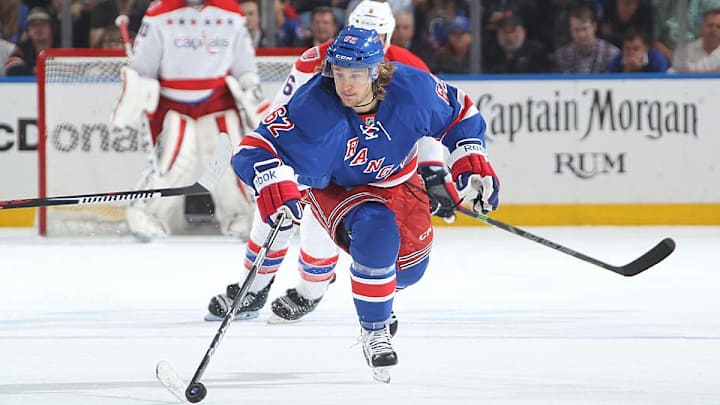Agent: NHL salary cap crunch may fuel run at restricted free agents

You know it works. In the NHL, restricted free agents are free in name only. Other teams won’t approach them because a) they don’t want to drive up the market for younger players and b) they don’t want to face a retaliatory offer sheet when one of their own reaches RFA status.
Still, the thought of adding a promising young player is so tempting. So every summer, fans wonder if this will finally be the year when the gloves come off and clubs start scrapping for the top talent. And every summer they’re disappointed when their team decides to look the other way.
But this summer has a slightly different feel to it. The pool of UFA talent is painfully shallow—Mike Green or Martin St. Louis, anyone? The RFA crop is loaded with proven young stars like Vladimir Tarasenko of the St. Louis Blues, Braden Holtby and Evgeny Kuznetsov of the Washington Capitals, Derek Stepan of the New York Rangers, Tyler Toffoli of the Los Angeles Kings, Jakob Silfverberg of the Anaheim Ducks, and Jonathan Bernier and Nazem Kadri of the Toronto Maple Leafs. And there’s a chance that a depressed salary cap could prevent some teams from making a competitive offer to their RFAs.
It’s a perfect storm that could see NHL GMs shove those gentlemen’s agreements aside and go straight for their throats of their peers in order to land the talent they need.
• Bettman says salary cap likely to be $71 million for 2015-16
At least that’s a scenario envisioned by one prominent player agent.
How the 2015 Stanley Cup finalist Tampa Bay Lightning were built
“The reality is the tighter the cap, the tighter teams are against the cap, it does open up more and more opportunity for a player to get an offer sheet,” Steve Bartlett told Buffalo's WGR radio on Thursday. “And the team, no matter how much they would like to keep him, will not be in a position to match.
“So if I was guessing, I don’t think there’s going to be a huge explosion of them, but I think there may be ... situations where a player with a team who can’t afford to even pay him what would be considered reasonable market value may have to turn to hoping he can get an offer sheet in order to get that because his own existing team can’t afford to match or meet the offer that he may get.”
You can take Bartlett’s perspective with a grain of salt. As an agent, he has a vested interest in a more active market for restricted players, so stirring up discussion of poaching can’t hurt his cause.
Then again, he’s one of the most respected men in his field. And he just might have his ear to the ground on this one.
• Notes: Blackhawks owner cries poverty; should Pens fans fret about sale?
Bartlett, who represents Tampa Bay star Ryan Callahan, Buffalo’s Brian Gionta and Minnesota’s Thomas Vanek among others, also boasts some unique insight into the process. In 2007, he negotiated a seven-year, $50 million deal with the Edmonton Oilers for the services of Vanek, who was then an RFA with Buffalo. The Sabres, who’d already lost Daniel Briere and Chris Drury to free agency, grudgingly matched the offer. Bartlett gamed the system to get the best deal he could for his client.
Could he or another agent do the same this summer? While it’s hard to imagine Tarasenko, Holtby, Stepan or Toffoli slipping away from their current clubs, there are others whose situations could put them in play.
How the 2015 Stanley Cup finalist Chicago Blackhawks were built
Boston’s Dougie Hamilton seems the most likely target, given his age (21), skill set (puck-moving defenseman) and the cap crunch facing the Bruins. It would make for a lousy start to the tenure of new GM Don Sweeney if he allowed the heir apparent to Zdeno Chara to slip out of his grasp, but so would overpaying a young player whose defensive commitment hasn’t quite caught up to his evident offensive gifts ... and might never.
It’s thought that the Bruins would like to get Hamilton signed for somewhere around $5 million per year, slightly above what Minnesota’s Jonas Brodin was given last summer. But that would test the limits of a franchise with nearly $63 million committed to just 15 players next season.
Given Hamilton’s potential, there likely are other clubs that would be happy to tie Boston’s hands with an offer sheet. And if it costs them a first-, a second- and a third-round pick (the compensation for a deal averaging $5,478,986 to $7,305,316) to add a player who instantly steps onto their top pair and stays there for another seven years, that’s a doable price.
After falling short again, what is next for the New York Rangers?
Chicago’s Brandon Saad is another possibility. Hawks GM Stan Bowman would likely move one or more veterans (Patrick Sharp and Brent Seabrook, for example) to free up the cap space needed to keep him, but there’s a limit to how far he can go with 17 players making nearly $67 million next year.
Stepan will be the top priority for Rangers GM Glen Sather this summer. The amount he shells out to retain his No. 1 center will determine if there’s enough left over to keep Carl Hagelin on board. The 26-year-old winger scored 17 goals this season but it’s the speed upgrade that would encourage another club to consider poaching him.
It all may end up being sound and fury, signifying nothing. Then again, this could be the year that everything changes.
(s/t The Score)
